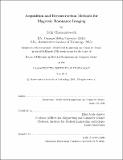| dc.contributor.advisor | Elfar Adalsteinsson. | en_US |
| dc.contributor.author | Chatnuntawech, Itthi | en_US |
| dc.contributor.other | Massachusetts Institute of Technology. Department of Electrical Engineering and Computer Science. | en_US |
| dc.date.accessioned | 2016-12-05T19:11:02Z | |
| dc.date.available | 2016-12-05T19:11:02Z | |
| dc.date.copyright | 2016 | en_US |
| dc.date.issued | 2016 | en_US |
| dc.identifier.uri | http://hdl.handle.net/1721.1/105570 | |
| dc.description | Thesis: Ph. D., Massachusetts Institute of Technology, Department of Electrical Engineering and Computer Science, 2016. | en_US |
| dc.description | This electronic version was submitted by the student author. The certified thesis is available in the Institute Archives and Special Collections. | en_US |
| dc.description | Cataloged from student-submitted PDF version of thesis. | en_US |
| dc.description | Includes bibliographical references (pages 119-138). | en_US |
| dc.description.abstract | Magnetic Resonance Imaging (MRI) is a non-invasive medical imaging modality that has a wide range of applications in both diagnostic clinical imaging and medical research. MRI has progressively gained in importance in clinical use because of its ability to produce high quality images of soft tissue throughout the body without subjecting the patient to any ionizing radiation. In addition to exquisite anatomical detail obtained from the conventional MRI, complementary physiological information is also available through emerging specialized applications of MRI such as magnetic resonance spectroscopic imaging, quantitative susceptibility mapping, functional MRI, and diffusion MRI. Despite its great versatility, MRI is limited by the long time required to acquire the data needed to form an image. Since a typical MRI protocol consists of multiple scans of the same patient, the total scan time is commonly extended beyond half an hour. During the session, the patient must remain perfectly still within a tight and closed environment, raising difficulties for certain populations such as children and patients with claustrophobia. The long acquisition time of MRI not only reduces the availability of the MRI scanner, but also results in patient discomfort, which often leads to motion that degrades image quality. Therefore, reducing the acquisition time of MRI is a well-motivated problem. This thesis proposes acquisition and reconstruction methods that increase the imaging efficiency of MRI and two of its emerging specialized applications, magnetic resonance spectroscopic imaging and quantitative susceptibility mapping. In particular, each of the proposed methods increases the imaging efficiency by achieving at least one of two aims: reduction of total scan time and improved image quality by mitigating image artifacts, while minimizing reconstruction time. | en_US |
| dc.description.statementofresponsibility | by Itthi Chatnuntawech. | en_US |
| dc.format.extent | 138 pages | en_US |
| dc.language.iso | eng | en_US |
| dc.publisher | Massachusetts Institute of Technology | en_US |
| dc.rights | M.I.T. theses are protected by copyright. They may be viewed from this source for any purpose, but reproduction or distribution in any format is prohibited without written permission. See provided URL for inquiries about permission. | en_US |
| dc.rights.uri | http://dspace.mit.edu/handle/1721.1/7582 | en_US |
| dc.subject | Electrical Engineering and Computer Science. | en_US |
| dc.title | Acquisition and reconstruction methods for magnetic resonance imaging | en_US |
| dc.type | Thesis | en_US |
| dc.description.degree | Ph. D. | en_US |
| dc.contributor.department | Massachusetts Institute of Technology. Department of Electrical Engineering and Computer Science | |
| dc.identifier.oclc | 963853531 | en_US |
